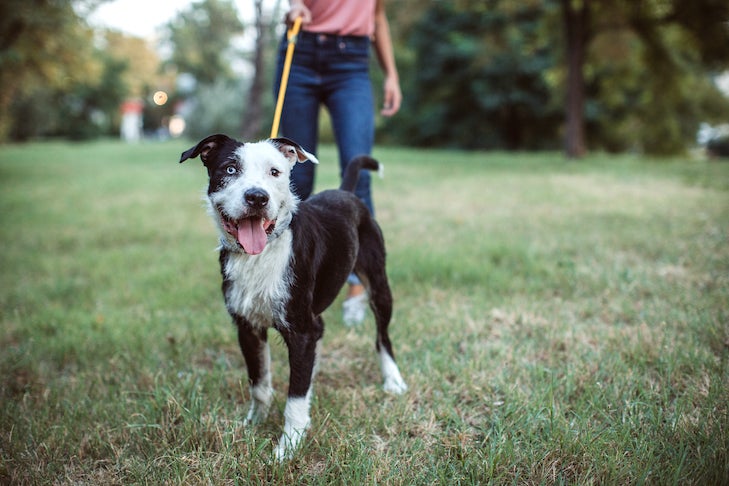Teach Your Dog an Incompatible Alternative Behavior
You can also teach your dog to perform a behavior that is incompatible with lunging. For example, they can’t lunge towards another dog and turn to look at you at the same time. If you heavily reward this alternative behavior, your dog will eventually choose to do it in place of lunging even when their trigger is close by. Some great choices include “Watch me” (where your dog looks at your face), “Touch” (where your dog targets something with their nose), or “Find it” (where you drop treats at your feet for your dog to find). These are easy to teach and easy for your dog to do even when they are emotionally aroused. And more importantly, they redirect your dog’s gaze from the trigger to you.
Whichever behavior you choose, make sure your dog loves to do it. Start training in a quiet environment without distractions and pile on the treats. This will show your dog how easy it is to get rewarded for the new task. Next, build distractions into your training. Then add the trigger at a below-threshold distance. When your dog looks at the trigger, ask for the replacement behavior. Shower them with treats when they obey. Finally, ask for the new behavior while slowly moving closer and closer to the trigger. If your dog reverts to lunging, you’ve moved too far, too fast. Eventually, rather than lunging, your dog will see the trigger as a cue to do the new behavior and earn a reward.

For some dogs, you might be able to work through these techniques on your own and achieve great success in a matter of weeks. For other dogs, it’s advisable to get help from an animal behaviorist or a professional dog trainer with leash reactivity experience. Your dog might also benefit from a consult with a veterinary behaviorist. If your dog is too worked up to learn, medication can control their arousal levels during training allowing them to make more progress.
Lunging on leash can usually be modified into more polite and acceptable behavior. At the very least, you can minimize your dog’s outbursts with good management. It takes patience and dedication to your dog and the training protocols, but walks can eventually be stress-free for both you and your dog.
Help! My Dog Barks & Lunges At People!
This overview will help you understand why your dog acts aggressively toward people and what you can do about it. Since it isn’t specific to your dog, however, you may want to consider working privately with one of the trainers on our referral list.
Nearly all reactivity is rooted in fear. Your dog’s aggressive behavior causes people to retreat, and then your dog feels safer. NEVER PUNISH A DOG FOR REACTIVE BEHAVIOR. If you yank on your dog or yell at him to stop, all you have done is reinforce the idea that people make bad things happen. And if you punish your dog for growling, your dog may go straight to biting without a clear warning sign. Your dog is actually giving you important information that can help keep both your dog and other people safe. He is telling you that he is too close to what is making him anxious – in this case, people.
You need to keep your dog away from people he is afraid of while you teach him that people can be trusted and that, in fact, good things happen when people are around. Every time your dog acts aggressively and the person backs off, your dog is more likely to repeat that behavior in the future. After all, IT WORKS.
Regular Visitors to Your Home
You may have regular visitors, such as relatives, neighbors, or close friends. You want your dog to be comfortable with these visitors and not have to go to his safe place every time they visit. Remember, though, that each of these people, regardless of how close they are to you, is a stranger to your dog. He may not know whether he can trust your best friend or your son-in-law. If your dog’s reaction is relatively mild, you can have your dog on a leash or tether at a safe distance. Give him treats from the moment you hear the car pull up or, if you miss that, the doorbell rings. Keep giving your dog one tiny treat after another while your guest walks through the hall to another room. Your guest should ignore your dog, so that your dog is not pushed beyond his comfort zone. When your dog can no longer see your guest, stop the treats. In your dog’s eyes, this visitor made treats happen and the treats stopped when the person went away.
You can also train your dog to run to his “safe place” for a Kong stuffed with his favorite foods. Practice with a friend who rings the doorbell, while you quickly walk to your dog’s safe room or crate with treats to entice him. Keep a few stuffed Kongs in the freezer to use when needed. Once your dog goes to “his place” easily, add a verbal cue that you will be able to use in the future. Getting your dog away from the door will keep your dog from practicing the barking / lunging behavior and will reduce his arousal level. Giving your dog something he likes at his designated spot will also help him think that your frequent visitors make good things happen.
Remember that one visitor is not the same as multiple visitors. Even if your dog learns to be comfortable around your best friend, your best friend’s family may be more than your dog can handle.